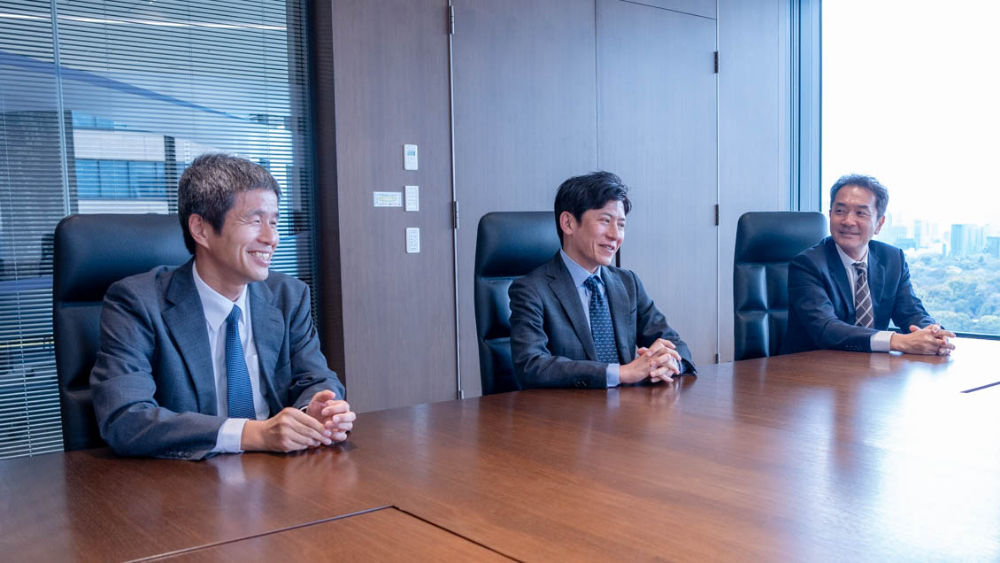- within Energy and Natural Resources topic(s)
- with readers working within the Technology industries
- within Technology topic(s)
Against the backdrop of growing global momentum toward realizing a decarbonized society, the clean energy sector is developing rapidly. In this roundtable discussion, six lawyers specializing in clean energy exchange their views on "The Frontline of the Energy Transition," discussing the key themes and challenges they have been seeing in practice and future prospects. The first session considers global trends in the energy sector before delving into the current state of the market and the challenges faced by the overseas expansion of Japanese companies.
Discussion Participants
- Reiji Takahashi
- Nobuyuki Maeyama
- Eiji Kobayashi
- Norihumi Takeuchi
- Kunihiro Yokoi
- James Hearne
1.Global Trends in the Energy Sector—Eight Major Trends

Hearne: We have been seeing eight global trends related to the energy transition.
The first trend to note is that globally last year, clean energy investment increased to a new record high, almost doubling the amount of fossil fuels investment and exceeding two trillion dollars for the first time. This is a historic event, which demonstrates the significant movement of capital toward the creation of a decarbonized society.
The second trend is the ongoing increase in both the supply and
demand of electricity, which comes with the global shift toward
electrification. The increase in supply of electricity is primarily
coming from the increasing number of renewable energy projects
coming online, with many more planned from a wide variety of
sources. In addition to renewables, there are many new fossil fuel
projects planned and there are predictions of a nuclear
renaissance, especially as new nuclear technologies continue to be
developed and adopted (including small modular reactors
("SMRs") and nuclear fusion). Therefore, electricity
supply will continue to increase from a diverse range of
sources.
On the demand side, growth in artificial intelligence
("AI"), electric vehicles ("EVs"), data
centers, and the broader digitalization of society, along with an
expanding middle class in emerging countries, is driving global
electricity demand, which is expected to continue growing.
The third trend involves the stagnation of offshore wind and the accelerating growth of solar energy. Offshore wind faces similar challenges in many countries: rising costs, supply chain bottlenecks, and inadequate policies and regulations. Meanwhile, the adoption of solar energy continues to speed up globally. In 2024, on a global basis, 80% of new electricity generation capacity was from renewables (representing around 700 GW of new renewables capacity), and from that percentage, 80% was from solar power. This reflects what we see in Japan too, with solar power expanding as the main power source while offshore wind faces challenges to grow.
The fourth trend is the increase in renewables M&A activity. If we look at energy M&A in general, renewables have been the main driver globally, much more so than fossil fuels. There has been an increase in deals where portfolios are acquired rather than individual projects, and more diverse players are becoming involved. We have been seeing increased interest from Japanese companies looking at overseas renewables M&A opportunities.

Hearne: The fifth trend is that as
net-zero targets are being reassessed, oil and gas, including
liquid natural gas ("LNG"), and nuclear power are being
reevaluated. There has been an increasing recognition that the
energy transition will be slower than hoped, and meeting net-zero
targets on time will be more challenging than originally
expected.
As a result, LNG and nuclear power are going to be part of the
energy mix for longer than previously anticipated. This was
recognized in Japan's recently announced Seventh Strategic
Energy Plan. Furthermore, recent exchanges between Japanese and
U.S. leaders, where Japan showed a positive stance toward procuring
increased LNG volumes from the U.S., are likely to encourage
Japanese companies to increase investments in overseas LNG projects
and increase their procurement of LNG generally. In relation to
this, I have recently advised some Japanese clients on procuring
new LNG supplies through long term LNG SPAs with overseas
sellers.
In this context, the importance of technologies such as Carbon
Capture and Storage ("CCS") and Carbon Dioxide Removal
("CDR") is increasing, assuming the continuation of an
energy mix which relies on fossil fuels.
Furthermore, as part of the reassessment of net-zero targets, in
recent months, we have seen Japanese banks join banks from the U.S.
and Canada in leaving the Net-Zero Banking Alliance
("NZBA").
The sixth trend is that with increasing electrification, the ownership of and access to critical minerals (including rare earths) is becoming increasingly competitive. The U.S. President's recent focus on critical minerals in Ukraine and Greenland shows how the need for critical minerals is influencing geopolitics. In line with these international developments, Japanese companies are seeking new investments in mining projects focused on critical minerals, and I have recently been involved in advising on several such investments into Australia.
The seventh trend concerns the spread of battery energy storage system ("BESS") projects. The deployment of BESS is accelerating both domestically and internationally, with co-located projects paired with renewable generation sources becoming more popular than independent projects. BESS projects are emerging as an essential part of the energy landscape as they play a crucial role in ensuring stable electricity supply to address the intermittency of renewable energy generation, which in turn helps bring stability and flexibility to the electricity grid.
Finally, the eighth trend is the slight cooling of interest toward hydrogen. On a global basis, the interest and excitement in hydrogen has been reducing. It is no longer discussed as a "dream technology" as often as before. Instead, a more realistic perspective based on technical and economic feasibility is spreading. Nevertheless, in Japan, interest remains high due to the government's clear policy commitment to realizing a hydrogen society. In fact, I am currently involved in advising Japanese clients on some exciting, large-scale overseas green hydrogen and ammonia projects.
2.Regional Characteristics of Clean Energy Development

Maeyama: I understand the systematic organization of global trends you have presented. These trends appear differently depending on the region, but what kind of energy development characteristics can be seen in different regions of the world?
Yokoi: With offshore wind and renewable energy technologies, we can see a pattern where they first develop in Europe and then expand to Asia, which is often the case. For hydrogen businesses, regions such as Europe, the Middle East, and Australia are at the center. The Middle East in particular has strong government support, with large-scale projects moving forward. For example, the world's first large-scale green hydrogen project also started in Saudi Arabia.
3.Overseas Expansion by Japanese Companies
Takeuchi: How are these global trends and regional characteristics influencing the strategies and overseas expansion of Japanese companies?
Yokoi: Among the Japanese companies we support, interest in overseas projects is definitely increasing. As profitability limitations become apparent in the domestic market, companies are gradually finding overseas expansion attractive, and I have the impression that more clients are actively seeking business expansion.
Previously, there has been a tendency for businesses to be involved in advanced projects, like offshore wind, to bring cutting-edge technology back to Japan, or to focus on highly profitable businesses in Asia. This basic direction continues today, but the scope is gradually expanding. For example, within offshore wind, investment in floating technology is also increasing.
In the Asian region, interest in renewable energy businesses has increased due to net-zero targets, with hydropower—particularly in Indonesia and the Philippines—showing progress where significant scale can be expected. In fact, our firm was involved in a project undertaken by a Japanese company in Indonesia last year. In Vietnam, solar and wind power projects continue to be numerous, and our Vietnam office also handles these. For overseas projects, we often work jointly with our overseas offices, especially our teams in Indonesia and Vietnam.

Yokoi: Regarding offshore wind, projects are also emerging in South Korea and Australia, but I think it may be too early for full-scale entry of Japanese companies into these markets. In Europe, investment in large-scale offshore wind projects continues, and some floating demonstration projects are nearing completion. We are also seeing Japanese operators trying to build deeper partnerships with cutting-edge developers, and our firm is providing support in such scenarios.
A major recent development is the expansion of green hydrogen.
Projects that produce hydrogen in combination with solar, offshore
wind, and onshore wind are increasing, and Japanese companies are
showing interest in these fields. Solar power development is also
active in the Middle East, the U.S., and Australia.
For M&As, we see various forms—Japanese companies
investing in project companies established for individual projects,
portfolio investments, and acquisitions of local developers seeking
growth. However, since local operations are not easy, there is a
tendency to start with minority investments and build partnerships
with local companies in the initial stages. Consultations by
companies regarding the drafting of partnership agreements and
related documents are also increasing.
More Japanese companies are focusing on investing in mineral
resources necessary for renewable energy technologies.
Manufacturers and energy operators are expanding their investments
beyond conventional fuels to mineral resources, and we are
increasingly involved in providing legal support for such
initiatives.
Takahashi: There are interesting developments from a government support perspective as well. When Japanese companies participate in joint ventures with foreign companies manufacturing new fuels, such as e-fuel, we are seeing cases where government financial institutions provide support for investment funds. The government is encouraging the early acquisition of cutting-edge technologies and their transfer to Japan. Advising government-affiliated financial institutions and support organizations is becoming one of our firm's important services.
Kobayashi: The trend of early investment in small overseas, energy tech companies does seem to be increasing. This could be described as a strategic move by Japanese companies to not fall behind the wave of technological innovation.
Looking Ahead
In this first session, we discussed a wide range of perspectives from global energy transition trends to the overseas expansion of Japanese companies. Starting with the analytical framework of eight major trends, we covered regional characteristics and specific strategies of Japanese companies, bringing you to the frontline of clean energy fields. In the next session, we will focus on the domestic renewable energy market trends, in particular solar power generation, and deepen our discussion.
The content of this article is intended to provide a general guide to the subject matter. Specialist advice should be sought about your specific circumstances.







